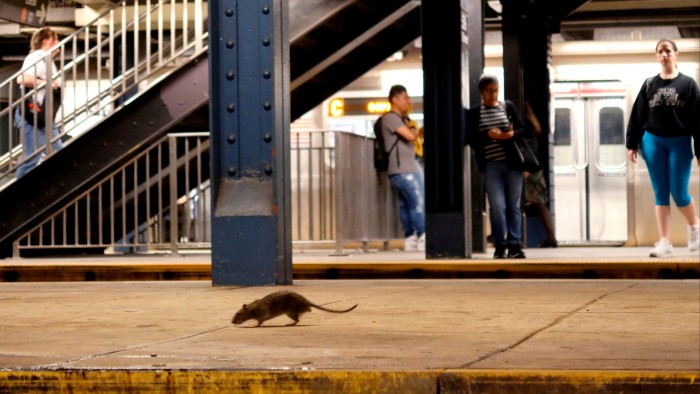Unlock the Editor’s Digest for free
Roula Khalaf, Editor of the FT, selects her favourite stories in this weekly newsletter.
Summer arrives suddenly in New York. One moment an icy wind blows down the Hudson; the next, temperatures soar and the city’s inhabitants emerge into the warm air. Some sightings are less welcome than others; the city’s notorious rat population also tends to rise with the temperature.
I’ve had my own encounters — including, memorably, when a rat ran into my leg as I walked home one evening. Last summer, my first in the city, I watched in horror as they darted beneath the outdoor dining platforms on which oblivious New Yorkers sat enjoying alfresco meals.
Rats exist on every continent except Antarctica but I’ve never seen them brazenly helping themselves to rubbish amid the diners at a sidewalk café anywhere but New York.
To understand why they are so visible here, I headed to a park in Brooklyn to meet Kathleen Corradi, the city’s first “rat tsar”. Dressed in black, with a baseball cap emblazoned with a “rat pack” logo, she is here to take a group of us on her rat walk, part of a community outreach effort.
“Shockingly little is known about urban rats,” Corradi tells us — although she seems to know a lot: they like to live underground, can fit through an opening the size of a quarter, can survive for days on the residue in discarded food packaging and reproduce at speed.
The rats found in New York are brown or Norway rats, rattus norvegicus. Exactly how many live here is anyone’s guess. Jonathan Richardson, a professor of biology at the University of Richmond who studies urban rats, says that it is almost impossible to count their numbers accurately.
Swift reproduction means their numbers can increase exponentially in a short time. “This is a species that’s beautifully adapted to reproduce and to do it quickly. And so that’s what creates such an uphill battle with management,” he says.
Richardson is clear that rats cannot be eradicated from urban environments, but their numbers can be kept in check. Key to this is keeping streets and parks clean. “The most effective strategy for managing them is to reduce their access to food resources,” he tells me. “New York was behind on all these things for a while, especially if you want to compare it to European cities.”
When New York mayor Eric Adams took office in 2022 he declared a war on rats, appointing Corradi and tasking her with designing a plan to co-ordinate agencies within the city’s sprawling bureaucracy.
Neighbourhoods with the worst infestations were targeted as mitigation zones, with intensive inspections by the city’s health department and fines for property owners who repeatedly failed to follow their instructions.
Throughout the city, buildings with fewer than nine apartments were ordered to put rubbish into lidded containers for collection. Larger buildings were to put it out in bags at specified times.
A pilot programme in West Harlem has mandated the use of sealed containers known as empire bins. The plan is to roll these out to the entire city.
“This is a massive change in how New York City handles its trash, getting it out of gross bags on the street and into containers that keep smells in and rats out,” says Vincent Gragnani of the NYC department of sanitation.
Back in Brooklyn, Corradi is showing us burrows next to a playground. Park staff have filled the entrances with gravel to deter the rats from returning. “It’s a bit like going home and finding your front door key doesn’t work,” she says.
Unfortunately, rattus norvegicus can chew its way through concrete (it can also jump three feet and has been filmed climbing up a metal pole in a subway car). The aim of the gravel is to introduce stress that slows down breeding. The goal is “sustained reduction”, Corradi says. “Silver bullets do not exist.”
One NYC innovation is a portal to report rodent sightings. On my way home I see a pile of rubbish bags piled up neatly along my street, ready for collection the following morning. A rat races out from one and disappears into the darkness and, shuddering slightly, I make my report on the portal, a diligent new member of New York’s rat pack.
